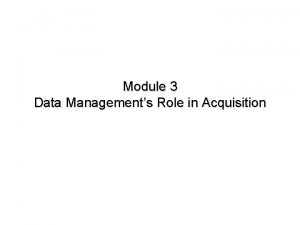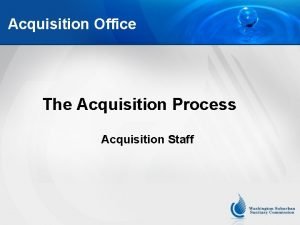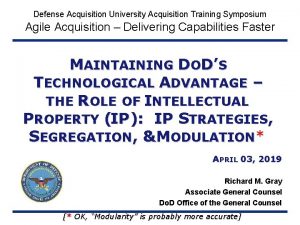Module 3 Data Managements Role in Acquisition Module








- Slides: 8

Module 3 Data Management’s Role in Acquisition

Module 3: Data Management and Acquisition • Learning Objectives: – Awareness of DM’s role from contract conception forward – Interpreting guidance to establish good DM methods and processes • Learning Outcomes: – How to define the DM program that meets user needs – Knowing areas of constraint, and special aspects of DM for the lifecycle

DM and Acquisition • DM’s purpose is to identify and provide data – Responsive to customer needs – Digitally, if possible – Acquiring minimum essential data • Access versus acquisition versus acceptance – Premises that are central to contemporary DM – Rules-based processes that present options and sometimes cost consequences for the user • Acquirer and Provider roles – Data delivery can be digital access and data rights can be purchased for digital products • • • Industry to government Industry to industry Government to government • Internally or externally – Customers come from both sources • Ownership versus stewardship role – Format contract or terms of agreement Acquisition to sustainment focus – data to sustain life cycle needs

Alternative Ways to Provide Data • Hard copy – However, increasingly electronic • Access to a database, PDM system, or repository – Data is used through “views”, or mined for information to gain insight and knowledge into program status • Ad hoc reports or standard report formats – “Data product” is a dynamic representation, in this environment • Collaborative development – Iterative data production, review, acceptance, and disposal between the acquirer and the provider • Data planning that is deliberately linked to acquisition strategy and data concept of operations – How the data will be used, for what purposes, and by whom • Data requirements authentication process – Preceded by a risk analysis • What if the data is purchased and no delivery or access is established? • Are there risks in overprocuring data? (obsolete data, insufficient data) New aspects in the contemporary DM model or process

Data Acquisition Enablers Review project strategy and planning Establish general requirements for data Develop data strategy and data concept of operations Determine specific data requirements Authenticate data requirements Award contract for data Context? Decision support? Perform data risk analysis Too early? Obsolete? Review the project strategy and determine the general needs for data over the product life cycle

Assessing Risk • Two major considerations – Over-provisioning • Providing data that is not useful or providing data prematurely, to the detriment of its accuracy and potential value – Under-provisioning • Failure to provide data when it is needed • Other risk factors – Inability to retrieve data (bad cataloguing or metadata development) – Loss of data (natural disaster, misplacement, or theft) – Obsolete data (retaining data that has no value) – Compromise of intellectual property

Data Environmental Assessment Understand strengths Understand threats Understand stakeholders Understand weaknesses Understand opportunities Understand power sources Understanding of DM Environment

Quiz • • • Alternative ways to provide data rather than hard copy include. . – – Access to a database Collaborative development environments Data strategies and data concepts of operation Data requirements authentication processes Data is not purchased in industry to industry transactions. True or False? Developing data strategy and a concept of operations is key to determining solution context. True or False? Risk analysis is designed to support buy or access decisions. True or False? The major considerations in risk assessment for DM are. . – – – Systems engineering and test and evaluation data needs Data obsolescence Theft or other loss of data Compromise of intellectual property Underprovisioning or poor planning for the system in the field All of the above, or none of the above? Understanding the data environmental factors involves identifying strengths and weaknesses that are present. True or False?
 Acquisition vs learning examples
Acquisition vs learning examples Data acquisition and data analysis
Data acquisition and data analysis What is data acquisition in data warehouse
What is data acquisition in data warehouse The acquisition of a traditional masculine or feminine role
The acquisition of a traditional masculine or feminine role Worker role azure
Worker role azure Interaktionistisches rollenmodell
Interaktionistisches rollenmodell Statuses and their related roles determine the structure
Statuses and their related roles determine the structure Citech scada
Citech scada Spatial data acquisition
Spatial data acquisition















